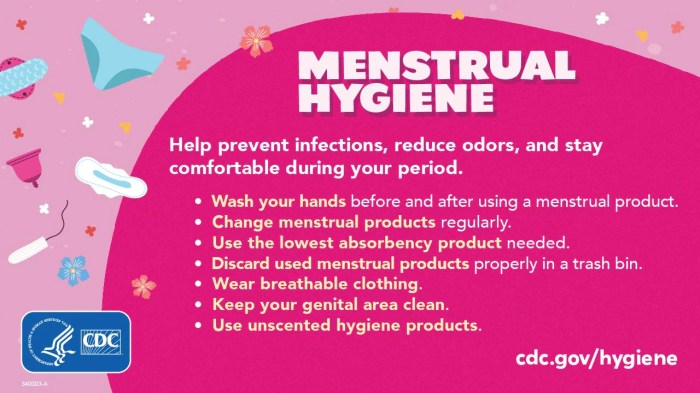
Let’s talk periods! Forget the hushed whispers and awkward glances – menstrual health is a vital part of overall well-being, affecting millions globally. This isn’t just about managing cramps; it’s about understanding your body, challenging societal stigmas, and ensuring access to essential information and resources. Get ready to dive into a frank, informative, and empowering discussion about menstrual health awareness!
From the science behind your monthly cycle to navigating common issues like dysmenorrhea and PCOS, we’ll cover it all. We’ll explore the importance of menstrual hygiene management, bust myths, and highlight the impact of period poverty on women’s lives. Prepare to be informed, empowered, and ready to advocate for better menstrual health for everyone!
Understanding Menstrual Health

Menstruation, a natural biological process, is a crucial aspect of reproductive health for women and girls. Understanding the intricacies of the menstrual cycle, its associated symptoms, and available management options is vital for promoting overall well-being. This section delves into the physiological mechanisms, hormonal influences, and common experiences surrounding menstruation.
Physiological Processes of Menstruation
Menstruation, or a period, is the monthly shedding of the uterine lining (endometrium). This shedding occurs when a fertilized egg doesn’t implant in the uterus. The process begins with the breakdown of the endometrium, leading to bleeding that typically lasts for three to seven days. The blood, along with tissue and mucus, is expelled from the body through the vagina.
This cyclical process is governed by a complex interplay of hormones.
Stages of the Menstrual Cycle and Hormonal Influences
The menstrual cycle is typically divided into four phases:
1. Menstrual Phase
This phase marks the beginning of the cycle, characterized by the shedding of the uterine lining and bleeding. Hormone levels, particularly estrogen and progesterone, are low.
2. Follicular Phase
Following menstruation, the follicle-stimulating hormone (FSH) stimulates the growth of follicles in the ovaries, each containing an egg. Estrogen levels gradually rise, thickening the uterine lining in preparation for a potential pregnancy.
3. Ovulatory Phase
A surge in luteinizing hormone (LH) triggers the release of a mature egg from a follicle (ovulation). This usually occurs around day 14 of a 28-day cycle, although the exact timing can vary.
4. Luteal Phase
After ovulation, the ruptured follicle transforms into the corpus luteum, which produces progesterone. Progesterone further thickens the uterine lining, preparing it for implantation. If fertilization doesn’t occur, the corpus luteum degenerates, leading to a decrease in progesterone and estrogen, initiating menstruation.
Common Menstrual Symptoms and Variations
A wide range of symptoms can accompany menstruation, varying in intensity and duration from person to person. Common symptoms include:* Cramps (dysmenorrhea): Painful uterine contractions.
Bloating
Fluid retention.
Breast tenderness
Swelling and sensitivity in the breasts.
Mood swings
Irritability, anxiety, or depression.
Headaches
Migraines or tension headaches.
Fatigue
Feeling tired and lethargic.
Acne
Increased breakouts.Variations in menstrual experiences are also common. Some individuals experience heavier or lighter flows, longer or shorter cycles, or irregular cycles. These variations can be influenced by factors such as stress, weight changes, and underlying medical conditions.
Comparison of Menstrual Products
The following table compares and contrasts different types of menstrual products:
| Product Type | Absorbency | Cost | Environmental Impact |
|---|---|---|---|
| Pads | Variable, depending on brand and type | Moderate to low | High (significant waste) |
| Tampons | Variable, depending on brand and absorbency | Moderate | Moderate (applicator waste, cotton production) |
| Menstrual Cup | High | High (initial cost), low (long-term) | Low (reusable, less waste) |
| Menstrual Disc | High | High (initial cost), low (long-term) | Low (reusable, less waste) |
Menstrual Health Issues and Challenges
Menstruation, a natural biological process, shouldn’t be a source of suffering or stigma. However, for many women and girls worldwide, it presents significant health issues and societal challenges that impact their well-being and overall quality of life. This section explores the prevalent conditions, societal barriers, and successful interventions aimed at improving menstrual health.
Prevalence and Impact of Menstrual Health Conditions
Dysmenorrhea, endometriosis, and polycystic ovary syndrome (PCOS) are common conditions affecting menstrual health, causing significant discomfort and impacting fertility. Dysmenorrhea, or painful periods, affects a large percentage of menstruating individuals, with some experiencing debilitating cramps that interfere with daily activities. Endometriosis, a condition where uterine tissue grows outside the uterus, can cause chronic pelvic pain, heavy bleeding, and infertility.
PCOS, a hormonal disorder, can lead to irregular periods, excessive hair growth, and acne, and increases the risk of long-term health problems like type 2 diabetes. The impact of these conditions extends beyond physical pain, affecting mental health, productivity, and social participation. For instance, a study published in the journal
Human Reproduction* found that women with endometriosis experienced significantly higher rates of depression and anxiety.
Social Stigma Surrounding Menstruation
Menstruation remains a heavily stigmatized topic in many cultures, leading to feelings of shame, embarrassment, and isolation for women and girls. This stigma manifests in various ways, from limited access to sanitary products and facilities to restrictive cultural practices that isolate menstruating individuals. The silence surrounding menstruation prevents open conversations about menstrual health, hindering access to essential information and support.
This stigma can significantly impact a woman’s education, employment opportunities, and overall social integration. For example, girls missing school due to menstruation can lead to significant educational setbacks and reduced future opportunities.
Barriers to Accessing Menstrual Health Information and Resources
Access to menstrual health information and resources varies significantly across different communities and socioeconomic groups. In many low-income countries, poverty and lack of infrastructure pose significant barriers to accessing sanitary products, clean water and sanitation facilities, and healthcare services. Lack of education and awareness about menstrual health also contributes to poor hygiene practices and increased risk of infections.
Furthermore, cultural norms and beliefs can restrict open discussions about menstruation, preventing women and girls from seeking help when needed. For example, in some communities, discussing menstruation openly is considered taboo, preventing women from seeking help for conditions like dysmenorrhea or seeking information about safe menstrual hygiene practices.
Successful Public Health Campaigns Promoting Menstrual Hygiene Management
Several successful public health campaigns have demonstrated the effectiveness of targeted interventions in improving menstrual hygiene management (MHM). These campaigns often involve multi-pronged approaches that combine education, advocacy, and provision of resources. For example, campaigns promoting the use of reusable sanitary pads in rural communities have shown positive impacts on hygiene practices and reduced school absenteeism among girls.
Other successful initiatives have focused on challenging societal stigma through public awareness campaigns and community engagement. These campaigns often involve working with local leaders and community members to change attitudes and behaviors related to menstruation. A successful campaign in Nepal, for instance, involved community-based education programs that taught girls about menstrual hygiene and empowered them to advocate for their needs.
This campaign resulted in increased school attendance and reduced stigma surrounding menstruation.
Menstrual Hygiene Management (MHM)
Menstrual Hygiene Management (MHM) encompasses all aspects of managing menstruation in a clean and safe way. It’s crucial for maintaining good health, promoting dignity, and ensuring the well-being of menstruating individuals. This includes the use of appropriate menstrual products, proper disposal methods, and regular hygiene practices. Neglecting MHM can lead to various health issues, impacting physical and mental well-being.
A Guide for Promoting Safe and Hygienic Menstrual Practices
This guide Artikels key steps for safe and hygienic menstrual practices, contributing to better health and well-being. Following these guidelines minimizes health risks and promotes a positive experience during menstruation.
- Choose appropriate menstrual products: Select products that suit your individual needs and preferences. Options include sanitary pads, tampons, menstrual cups, and reusable cloth pads. Consider factors like absorbency, comfort, and cost-effectiveness.
- Change products regularly: The frequency of changing products depends on the product type and your flow. Follow the manufacturer’s instructions and change products as needed to prevent infections and discomfort. For example, sanitary pads should generally be changed every 4-6 hours, while tampons should be changed every 4-8 hours.
- Practice proper handwashing: Thorough handwashing before and after handling menstrual products is essential to prevent the spread of bacteria. Wash your hands with soap and water for at least 20 seconds, paying attention to all areas, including between fingers and under nails.
- Maintain genital hygiene: Gently cleanse the genital area with warm water. Avoid harsh soaps or douches, as these can disrupt the natural vaginal pH balance. Use clean towels or tissues and avoid harsh scrubbing.
- Wear clean clothing: Change your underwear and outer clothing regularly, especially if they become soiled. Preferably use breathable fabrics like cotton to prevent irritation and discomfort.
Tips for Managing Menstrual Discomfort and Pain Naturally
Many women experience discomfort or pain during menstruation. These natural remedies can help alleviate some of the common symptoms. Remember that these are complementary approaches and should not replace medical advice for severe pain.
- Apply heat: A warm water bottle or heating pad placed on the lower abdomen can help relieve cramps.
- Gentle exercise: Light physical activity, such as walking or yoga, can improve blood flow and reduce pain.
- Rest and relaxation: Adequate rest and stress reduction techniques like deep breathing or meditation can ease discomfort.
- Dietary adjustments: A balanced diet rich in fruits, vegetables, and whole grains can help regulate hormones and reduce symptoms. Some individuals find that reducing caffeine and processed foods helps.
- Over-the-counter pain relief: Ibuprofen or naproxen can help manage pain and inflammation. Always follow the dosage instructions.
Proper Disposal Methods for Menstrual Products to Protect the Environment
Responsible disposal of menstrual products is vital for environmental protection and public health. Improper disposal can lead to sanitation issues and environmental pollution.
- Wrap used products properly: Wrap used sanitary pads and tampons in toilet paper or a biodegradable bag before disposing of them.
- Dispose of products in designated bins: Follow local guidelines for waste disposal. In some areas, specific bins are provided for sanitary waste.
- Consider eco-friendly options: Reusable menstrual cups and cloth pads are more sustainable alternatives to disposable products, significantly reducing waste.
- Avoid flushing products: Flushing tampons and sanitary pads can clog plumbing systems and cause environmental damage. Always dispose of them in trash cans.
- Properly clean and sterilize reusable products: Follow the manufacturer’s instructions carefully to ensure hygiene and longevity of reusable menstrual products.
Visual Representation of Proper Handwashing Technique
Imagine a detailed image showing two separate sequences: Before and After Menstrual Product Use. Before: A person is depicted at a sink with running water. Their hands are visibly dirty, perhaps with a subtle hint of a menstrual product stain. The soap is clearly visible, and the individual is shown lathering their hands thoroughly, paying close attention to the spaces between fingers, around the nails, and the back of their hands.
The water is running, and the focus is on the meticulous scrubbing action. After: The same person is now rinsing their hands under clean running water, ensuring all soap is removed. Their hands are now clean and visibly free of any dirt or stains. The image emphasizes the thoroughness of the rinsing process. A towel is nearby, and the person is about to dry their hands completely.
The overall tone is one of cleanliness and hygiene. The background is simple and uncluttered, focusing attention on the handwashing process itself.
Menstrual Health and Women’s Well-being

Menstrual health is inextricably linked to a woman’s overall physical and mental well-being. Ignoring or inadequately managing menstrual health can have significant repercussions across various aspects of a woman’s life, impacting her quality of life and contributing to broader societal inequalities. Understanding this connection is crucial for promoting women’s health and achieving gender equality.Menstrual health significantly impacts physical and mental health.
The Correlation Between Menstrual Health and Overall Physical and Mental Health
Poor menstrual health, characterized by conditions like dysmenorrhea (painful periods), endometriosis, and premenstrual syndrome (PMS), can lead to chronic pain, fatigue, and significant emotional distress. These conditions can interfere with daily activities, productivity, and overall quality of life. For example, severe dysmenorrhea can necessitate time off from work or school, impacting economic stability and educational attainment. The hormonal fluctuations associated with menstruation can also exacerbate existing mental health conditions like anxiety and depression.
Conversely, managing menstrual health effectively through strategies like proper hygiene, pain management techniques, and access to healthcare can positively influence a woman’s physical and mental well-being, leading to increased energy levels, improved mood, and reduced absenteeism from work or school.
Menstrual Health’s Impact on Education, Employment, and Social Participation
The stigma surrounding menstruation often prevents open discussion and limits access to necessary resources. This can negatively impact women’s education and employment opportunities. Many girls miss school during their periods due to lack of access to sanitary products, clean toilets, and appropriate disposal facilities. This absenteeism can lead to poor academic performance and reduced educational attainment, limiting future opportunities.
Similarly, in the workplace, inadequate menstrual health management can lead to reduced productivity, absenteeism, and even job loss. Social participation is also affected, as women may avoid social gatherings or activities due to discomfort or shame associated with menstruation. For example, a study in rural India showed a direct correlation between lack of access to sanitary products and girls dropping out of school.
This highlights the significant societal cost of neglecting menstrual health.
Addressing Menstrual Health and its Contribution to Gender Equality
Addressing menstrual health is a critical step towards achieving gender equality. By ensuring access to sanitary products, education, and healthcare, we empower women to manage their menstrual cycles effectively and participate fully in all aspects of life. This includes breaking down societal stigmas and promoting open conversations about menstruation. For instance, providing free or subsidized sanitary products in schools and workplaces can significantly reduce the financial burden on women and increase school attendance and workplace productivity.
Comprehensive sex education that includes accurate information about menstruation can empower girls and women to make informed decisions about their health. These initiatives not only improve women’s individual well-being but also contribute to a more equitable and just society.
Strategies for Empowering Women to Take Control of Their Menstrual Health
Empowering women to manage their menstrual health requires a multi-pronged approach. This includes improving access to affordable and high-quality sanitary products, providing comprehensive sex education, and ensuring access to healthcare services. Additionally, it is crucial to challenge societal stigmas and promote open conversations about menstruation. Strategies could include public awareness campaigns, community-based education programs, and the development of supportive policies in schools and workplaces.
For example, implementing menstrual hygiene management programs in schools can significantly improve girls’ attendance and academic performance. Similarly, creating supportive workplace policies, such as providing menstrual leave, can improve employee productivity and reduce absenteeism. These strategies, when implemented effectively, can significantly improve women’s overall well-being and contribute to a more equitable society.
Women & Health
Women’s health encompasses a broad spectrum of physical, mental, and emotional well-being, evolving significantly throughout their lifespan. Understanding these diverse needs is crucial for providing appropriate and effective healthcare. From puberty to menopause and beyond, women face unique challenges that require specialized attention and proactive approaches to maintain optimal health.
Diverse Health Concerns Across the Lifespan
Women’s health concerns vary considerably depending on their age and life stage. During adolescence, issues like reproductive health, body image, and mental health concerns like anxiety and depression often take center stage. Reproductive health continues to be a significant focus in adulthood, encompassing concerns such as contraception, pregnancy, and postpartum care. The risk of certain cancers, such as breast and cervical cancer, also increases with age.
Menopause brings its own set of challenges, including hormonal fluctuations, osteoporosis, and cardiovascular disease. In later life, chronic conditions like arthritis and dementia become more prevalent. A holistic approach, considering the interconnectedness of these concerns, is essential for comprehensive women’s healthcare.
Unique Healthcare Needs Across Age Groups
Adolescent girls require education on reproductive health, including menstruation, sexually transmitted infections (STIs), and healthy relationships. Young adult women often need support with family planning, contraception choices, and screening for STIs. Women of reproductive age require regular check-ups focusing on pregnancy-related health, including prenatal care and postpartum support. Perimenopausal and menopausal women need guidance on managing hormonal changes, including hormone replacement therapy (HRT) if necessary, and addressing osteoporosis risk.
Older women require care focused on managing chronic conditions and age-related health issues. These varied needs necessitate tailored healthcare strategies that address the specific concerns of each life stage.
Importance of Preventative Healthcare Measures
Preventative healthcare plays a pivotal role in maintaining women’s health throughout their lives. Regular check-ups, including Pap smears for cervical cancer screening and mammograms for breast cancer screening, are vital for early detection and treatment. Vaccinations against HPV and influenza are also crucial for preventing serious illnesses. Maintaining a healthy lifestyle, including regular exercise, a balanced diet, and stress management techniques, significantly contributes to overall well-being.
Early intervention and lifestyle modifications can effectively prevent or delay the onset of many chronic diseases. For instance, regular exercise can mitigate the risk of osteoporosis later in life, while maintaining a healthy weight reduces the risk of developing type 2 diabetes.
Resources for Women Seeking Information and Support
Access to reliable information and support is crucial for women managing their health concerns. Several resources are available to help women navigate their healthcare journey.
- National Women’s Health Network: Offers information on various women’s health issues and advocates for women’s health rights.
- American College of Obstetricians and Gynecologists (ACOG): Provides comprehensive information on reproductive health and women’s health concerns.
- National Institutes of Health (NIH): Offers extensive research and information on various health topics, including women’s health.
- Planned Parenthood: Provides comprehensive reproductive health services, including education, contraception, and STI testing.
- Local health departments and community health centers: Offer various services, including screenings, vaccinations, and health education programs.
Addressing Menstrual Health Disparities
Menstrual health disparities represent a significant global challenge, impacting millions of women and girls worldwide. Unequal access to menstrual health resources, shaped by complex interplay of social, economic, and cultural factors, creates profound health, educational, and economic consequences. Understanding these disparities is crucial for developing effective and equitable solutions.
Factors Contributing to Menstrual Health Disparities
Several interconnected factors contribute to the unequal distribution of menstrual health resources and information. These factors create barriers for many individuals, limiting their ability to manage their periods with dignity and safety. Socioeconomic status plays a critical role, influencing access to sanitary products, healthcare, and education. Geographic location also plays a significant role, with remote and underserved areas often lacking infrastructure and resources.
Furthermore, deeply ingrained cultural beliefs and practices surrounding menstruation can create stigma and shame, hindering open discussion and access to essential services.
Socioeconomic Status and Menstrual Health
Low socioeconomic status is strongly associated with limited access to menstrual hygiene products. For many women and girls living in poverty, the cost of sanitary pads or tampons represents a significant financial burden, forcing them to resort to less hygienic alternatives, increasing their risk of infection and other health problems. This financial constraint often extends to access to healthcare services for menstrual-related issues, leading to delayed or forgone treatment.
For example, a study in rural Kenya found that girls from impoverished households were more likely to miss school during their periods due to a lack of sanitary products and the associated shame and discomfort. This illustrates how poverty directly impacts a girl’s education and overall well-being.
Geographic Location and Access to Menstrual Health Resources
Geographic location significantly influences access to menstrual health resources. Women and girls living in rural areas, particularly in developing countries, often face significant challenges in accessing sanitary products, healthcare facilities, and educational programs on menstrual health. Limited infrastructure, poor transportation, and a lack of healthcare providers in these areas create substantial barriers. For instance, in many parts of sub-Saharan Africa, the distance to the nearest health clinic can be prohibitive, making it difficult for women to seek medical attention for menstrual-related problems.
This geographical isolation contributes to higher rates of menstrual-related illnesses and complications.
Cultural Beliefs and Menstrual Health
Cultural beliefs and practices surrounding menstruation can significantly influence attitudes and behaviors related to menstrual health. In some cultures, menstruation is stigmatized, leading to social exclusion, restrictions on activities, and a reluctance to seek help for menstrual-related problems. These beliefs can prevent open communication about menstruation, hindering access to education and support. For example, in certain communities, menstruating girls are prohibited from participating in religious ceremonies or social gatherings, reinforcing stigma and isolation.
This cultural stigma can have significant psychological and social consequences.
Initiatives to Improve Menstrual Health Equity
Numerous initiatives are underway to address menstrual health disparities and promote equity. These initiatives range from providing free or subsidized menstrual products to implementing comprehensive menstrual health education programs. Non-governmental organizations (NGOs) play a vital role in delivering these services, often partnering with local communities and governments. Some initiatives focus on developing affordable and sustainable menstrual hygiene products, such as reusable cloth pads, while others promote policy changes to ensure access to menstrual health resources for all.
For example, several countries have implemented tax reductions or subsidies on sanitary products to make them more affordable. These efforts are gradually shifting the narrative around menstruation, fostering a more open and supportive environment.
Strategies to Improve Access to Menstrual Health Products and Education
A multi-pronged approach is needed to improve access to menstrual health products and education in underserved communities. This includes increasing the availability of affordable and accessible sanitary products through government subsidies, community-based distribution programs, and the promotion of reusable alternatives. Comprehensive menstrual health education programs should be integrated into school curricula and community outreach initiatives to address stigma, promote hygiene practices, and empower women and girls with knowledge about their bodies.
Furthermore, strengthening healthcare systems to ensure access to menstrual health services, including reproductive health care, is essential. This collaborative effort, involving governments, NGOs, and communities, is crucial to achieve menstrual health equity.
Ending Remarks
So, there you have it – a whirlwind tour of menstrual health awareness! Remember, understanding your cycle is key to taking charge of your well-being. By challenging taboos, advocating for better access to resources, and prioritizing your health, we can create a world where menstruation is celebrated, not stigmatized. Let’s continue the conversation, share this information, and work together to improve menstrual health for all women!
Top FAQs
What is the average length of a menstrual cycle?
The average menstrual cycle lasts around 28 days, but it’s perfectly normal for cycles to range from 21 to 35 days.
How long does a period typically last?
Most periods last between 3 and 7 days.
Is it normal to experience PMS symptoms?
Yes! Many women experience premenstrual syndrome (PMS) symptoms like bloating, mood swings, and breast tenderness before their period. If symptoms are severe, consult a doctor.
What should I do if I experience excessively heavy bleeding?
If you experience unusually heavy bleeding (menorrhagia), seek medical attention. This could indicate an underlying issue.
Are there any natural ways to manage menstrual cramps?
Yes! Heat packs, gentle exercise, yoga, and over-the-counter pain relievers can help manage menstrual cramps. A balanced diet and stress reduction techniques are also beneficial.





